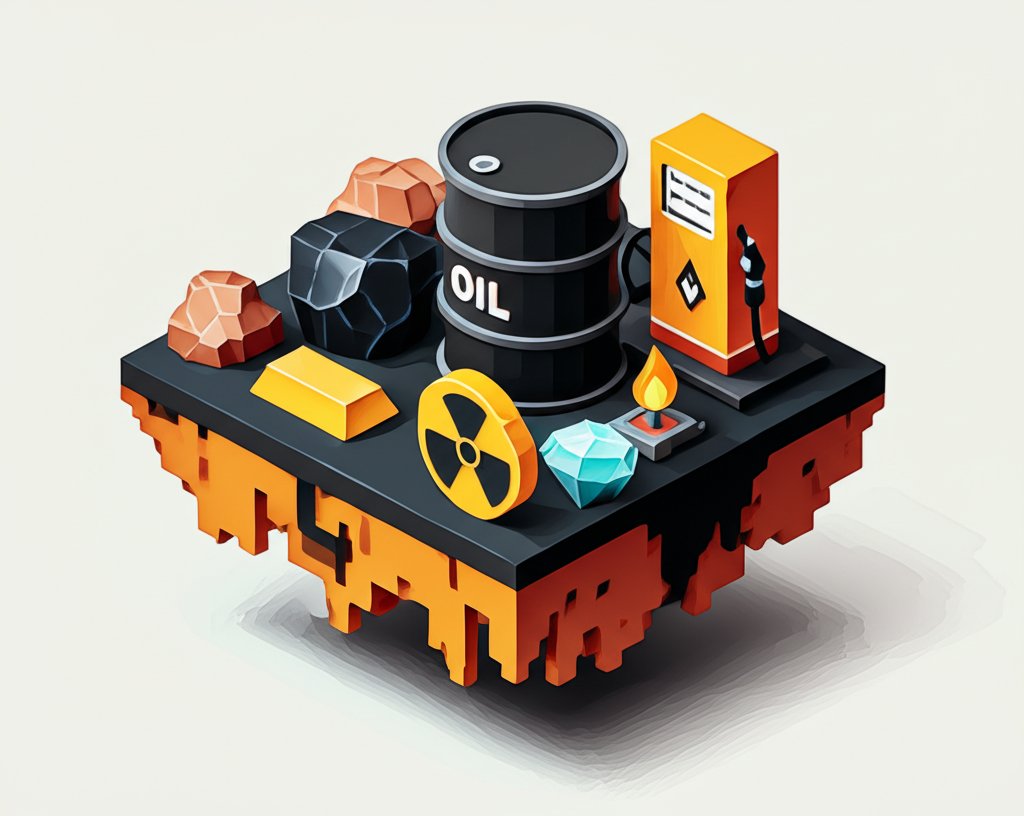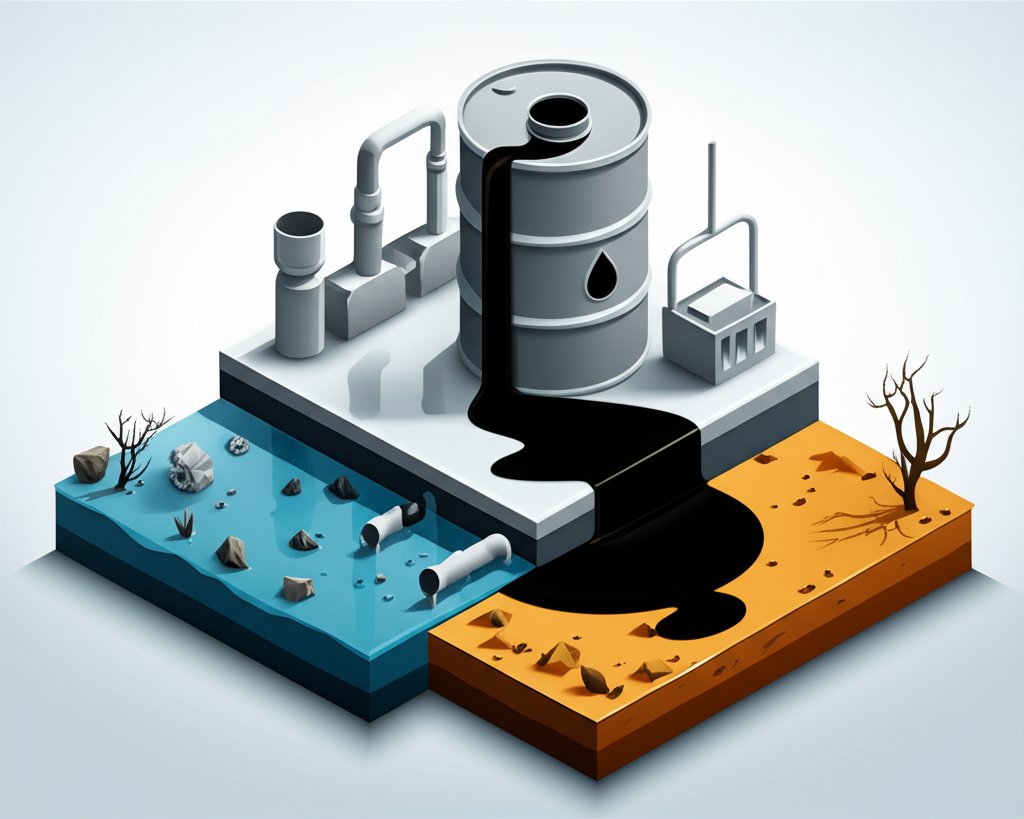In an interconnected world driven by innovation and industry, understanding the fundamental resources that fuel our civilization is more critical than ever. While renewable resources like solar and wind power capture headlines for their sustainable promise, a vast array of non-renewable resources continues to form the bedrock of our modern existence. These finite treasures, formed over geological timescales millions of years ago, power our homes, build our cities, and enable our technologies.
This comprehensive article will dive deep into the world of non-renewable resources, highlighting their indispensable roles, the intricate processes of their formation, and crucially, the profound environmental and socio-economic impacts tied to their extraction and consumption. We will spotlight 10 examples of non-renewable resources that are essential to our daily lives, from the fuels that drive our vehicles to the minerals in our electronics. By exploring these vital but limited assets, we aim to shed light on why a transition towards sustainable practices and alternative energy is not just an option, but an urgent necessity for future generations.
Unpacking Non-Renewable Resources: Definition, Formation, and Urgency

Non-renewable resources are natural substances that exist in fixed amounts and cannot be replenished on a human timescale. Once they are extracted and consumed, they are gone forever, or their regeneration takes millions of years, far exceeding our rate of use. This inherent finiteness is what distinguishes them from renewable counterparts.
What Makes a Resource “Non-Renewable”?
The core characteristic of a non-renewable resource is its slow formation process. These resources are typically products of specific geological conditions enduring over vast epochs. For instance, an example of a nonrenewable resource is fossil fuels, which are derived from the organic remains of prehistoric plants and animals. Over millions of years, these organic materials were buried under layers of sediment, subjected to immense heat and pressure, transforming them into the energy-dense substances we exploit today.
The Geological Clock: How Non-Renewables Form
- Fossil Fuels (Coal, Oil, Natural Gas): Begin as organic matter (plants, plankton, algae) that accumulates in oxygen-poor environments, preventing complete decomposition. Buried under sediment, rock, and water, increasing heat and pressure convert this matter into kerogen, then into crude oil, natural gas, or solid coal seams. This process can take hundreds of millions of years.
- Minerals and Metals (Iron, Copper, Rare Earths): Form through diverse geological processes, including volcanic activity, hydrothermal fluid circulation, plate tectonics, and sedimentation. Ores, which are rocks containing valuable minerals, concentrate metals over millions of years due to these geological forces. For example, some metal deposits form as molten rock cools and crystallizes, while others precipitate from hot, mineral-rich waters flowing through cracks in the Earth’s crust.
- Nuclear Fuels (Uranium): Uranium deposits are typically found in specific geological formations where uranium-rich fluids have seeped into porous rocks, precipitating and concentrating the radioactive element over vast periods.
The Double Bind: Finiteness and Accessibility Challenges
Even with new discoveries, the accessibility of non-renewable resources poses significant hurdles. Many new deposits are found in deeper, more remote, or environmentally sensitive locations. Extracting these resources often requires technologically advanced, energy-intensive, and costly methods, such as deep-sea drilling, hydraulic fracturing (fracking), or large-scale open-pit mining. These operations not only incur high economic costs but also carry substantial environmental risks, including habitat destruction, water pollution, and increased greenhouse gas emissions.
The dwindling supply, coupled with increasing demand and complex extraction, underscores the urgent need to understand and manage these resources responsibly. This brings us to the 10 non renewable resources that are foundational to our world.
The Core 10: Must-Know Non-Renewable Resources & Their Global Significance
Here are 10 examples of non renewable resources that play indispensable roles in our modern society, along with their primary uses and formation.
1. Coal: The Powerhouse of Industry
- Formation: Formed from ancient plant matter in swampy environments, buried and subjected to millions of years of heat and pressure, leading to carbonization.
- Uses: Primarily used for electricity generation (thermal power plants), steel production, and cement manufacturing.
- Impact: Significant contributor to air pollution, acid rain, and greenhouse gas emissions (CO2), leading to climate change. Mining causes landscape degradation and water pollution.
2. Crude Oil (Petroleum): The Lifeblood of Transportation
- Formation: Derived from the remains of ancient marine organisms (plankton, algae) buried under sediment layers in oceans and lakes, subjected to intense heat and pressure over millions of years.
- Uses: Refined into gasoline, diesel, jet fuel, heating oil, and used as a feedstock for plastics, chemicals, and pharmaceuticals.
- Impact: Oil spills cause catastrophic environmental damage. Combustion releases CO2, nitrogen oxides, and particulate matter, contributing to air pollution and climate change. Extraction can damage ecosystems.
3. Natural Gas: A Versatile Energy Source
- Formation: Often found alongside crude oil, formed from similar marine organic matter. Methane, the primary component, is a gas under normal conditions.
- Uses: Electricity generation, residential and commercial heating, industrial processes, and as a vehicle fuel (CNG, LNG).
- Impact: Burns cleaner than coal or oil, but still a significant source of CO2. Methane leakage (a potent greenhouse gas) during extraction and transport is a major concern. Hydraulic fracturing (fracking) for shale gas raises concerns about water contamination and seismic activity.
4. Uranium: Fuel for Nuclear Power
- Formation: A naturally occurring radioactive heavy metal, concentrated in specific geological deposits through hydrothermal processes and weathering over millions of years.
- Uses: Primary fuel for nuclear power plants, which generate electricity through nuclear fission. Also used in medical isotopes and weapons.
- Impact: Produces no greenhouse gas emissions during operation. However, mining can be environmentally destructive, and safe disposal of radioactive waste (spent fuel) is a long-term challenge, posing risks of contamination and proliferation.
5. Iron Ore: The Foundation of Modern Infrastructure
- Formation: Primarily found in sedimentary rock formations (banded iron formations) that formed billions of years ago when oxygen reacted with dissolved iron in ancient oceans.
- Uses: Essential for producing steel, which is the backbone of construction, automotive, machinery, and countless other industries. An example of a nonrenewable resource is iron ore, critical for urban development.
- Impact: Large-scale mining operations lead to landscape alteration, habitat destruction, and significant energy consumption. Steel production is a major emitter of CO2.
6. Copper: The Conductor of Modern Life
- Formation: Found in various geological settings, including porphyry deposits, stratiform deposits, and volcanogenic massive sulfide deposits, formed over geological time through hydrothermal and magmatic processes.
- Uses: Crucial for electrical wiring, electronics, plumbing, construction, and coinage due to its excellent conductivity and malleability.
- Impact: Mining often involves large open-pit operations, leading to habitat loss, soil erosion, and significant water and energy use. Smelting copper is energy-intensive and can release sulfur dioxide, contributing to acid rain.
7. Bauxite (Aluminum Ore): Lightweight and Ubiquitous
- Formation: Forms from the intense weathering of aluminum-rich rocks in tropical and subtropical climates over millions of years, concentrating aluminum hydroxides.
- Uses: The primary ore for aluminum production, used extensively in aerospace, automotive, packaging, construction, and consumer goods due to its lightweight and corrosion resistance.
- Impact: Bauxite mining (often open-cast) can cause deforestation, habitat destruction, and soil degradation. The Hall-Héroult process for aluminum smelting is extremely energy-intensive, relying heavily on electricity.
8. Phosphate Rock: The Nutrient for Global Agriculture
- Formation: Primarily forms from the accumulation of organic matter, particularly marine animal remains and excrement, in ancient seabeds over vast geological periods.
- Uses: The main source of phosphorus, a critical nutrient for plant growth. Used to produce fertilizers essential for global food security.
- Impact: Mining can disrupt ecosystems and deplete limited reserves. Excessive use of phosphate fertilizers can lead to nutrient runoff into waterways, causing eutrophication (algal blooms) and harming aquatic life.
9. Limestone: A Cornerstone of Construction
- Formation: A sedimentary rock composed primarily of calcium carbonate, formed from the accumulation of marine organism shells and skeletons over millions of years in ancient shallow seas.
- Uses: A raw material for cement, concrete, and mortar. Also used in agriculture (soil neutralizer), as a flux in steelmaking, and in flue gas desulfurization.
- Impact: Quarrying limestone leads to significant landscape alteration, dust pollution, and habitat fragmentation. Cement production is a major industrial source of CO2 emissions.
10. Rare Earth Elements (REEs): Enablers of High-Tech Living
- Formation: A group of 17 chemically similar metallic elements found dispersed in the Earth’s crust, concentrated in specific ore deposits through complex geological processes.
- Uses: Indispensable in modern high technology, including smartphones, electric vehicle batteries, wind turbines, solar panels, medical imaging, and military applications.
- Impact: Mining and processing of REEs are environmentally challenging, often involving toxic chemicals and generating large amounts of radioactive waste, impacting water, soil, and air quality. The geographically concentrated nature of deposits also poses geopolitical risks.
These ex of non renewable resources underscore our profound reliance on finite geological wealth, making their careful management and the pursuit of alternatives paramount.
Profound Impacts: Environmental, Economic, and Social Ramifications

The extensive use of the 10 non renewable resources outlined above has far-reaching consequences that challenge our planet and societies. Recognizing these impacts is the first step toward effective mitigation.
Environmental Degradation and Climate Change
- Habitat Destruction and Biodiversity Loss: Mining for minerals, metals, and fossil fuels often involves clearing vast areas, leading to deforestation, soil erosion, and the destruction of critical habitats. This directly contributes to the loss of biodiversity.
- Pollution (Air, Water, Soil): Extraction, processing, and burning of non-renewable resources release pollutants. Fossil fuel combustion emits greenhouse gases (CO2, methane), sulfur dioxide, and nitrogen oxides, leading to global warming, acid rain, and respiratory issues. Mining operations can contaminate local water sources with heavy metals and chemical runoff.
- Water Scarcity: Many extraction processes, particularly for mining and hydraulic fracturing, are extremely water-intensive, exacerbating water stress in already arid regions.
- Landscape Alteration: Open-pit mines, mountaintop removal, and extensive infrastructure development permanently alter landscapes, leaving behind scars that may take centuries to recover, if ever.
Economic Volatility and Geopolitical Tensions
- Resource Depletion and Price Volatility: As accessible non-renewable resources dwindle, extraction costs rise, leading to price spikes and economic instability. Nations reliant on imports become vulnerable to supply disruptions and price manipulations.
- Geopolitical Conflicts: The uneven distribution of critical non-renewable resources, such as oil and rare earth elements, often leads to competition, trade disputes, and even armed conflicts as nations vie for control over vital supplies.
- Economic Dependence: Economies heavily reliant on non-renewable resource extraction face booms and busts tied to commodity prices, hindering diversification and long-term sustainable growth.
Social and Health Implications
- Displacement of Communities: Large-scale mining or energy projects can displace indigenous communities and local populations, disrupting traditional livelihoods and social structures.
- Health Hazards: Exposure to pollutants from mining and fossil fuel combustion leads to higher rates of respiratory diseases, cancers, and other health problems in nearby communities and for workers.
- Labor Practices: The resource extraction industry can be rife with hazardous working conditions and, in some regions, questionable labor practices.
Navigating the Future: Strategies for Sustainable Resource Management
Given the critical role and profound impacts of these 5 non renewable resources (and all ten discussed), a concerted effort towards sustainable management and alternative solutions is imperative.
1. Conservation and Efficiency: Reducing Demand
The most direct way to extend the lifespan of non-renewable resources is to simply use less.
2. Recycling and Reuse: Closing the Loop
A circular economy approach, where resources are kept in use for as long as possible, is vital.
3. Transition to Renewable Energy Sources
For energy-related non-renewable resources, the shift to renewables is non-negotiable.
4. Innovation and Alternative Materials
Scientific advancements can help reduce our reliance on specific non-renewable materials.
5. Policy and International Cooperation
Effective governance and global collaboration are essential to drive change.
Conclusion
Non-renewable resources have undeniably shaped our past and continue to power our present. From the fossil fuels that drive our global economy to the critical minerals embedded in our technological devices, understanding their nature and impact is fundamental. We’ve explored 10 examples of non renewable resources — coal, oil, natural gas, uranium, iron ore, copper, bauxite, phosphate rock, limestone, and rare earth elements — each a testament to Earth’s geological richness and our ingenuity in harnessing it.
However, this reliance comes with a heavy price: environmental degradation, climate change, socio-economic disparities, and the undeniable reality of depletion. The finite nature of these resources beckons us towards a future where sustainability is not a choice, but a core principle. By embracing robust conservation efforts, championing recycling and reuse, accelerating the transition to renewable energy, and fostering innovation in material science, humanity can navigate this critical juncture. The path forward demands collective action, responsible stewardship, and a commitment to ensuring that both our current needs and the well-being of future generations are met with wisdom and foresight.
FAQ
Q1: What are non-renewable resources?
A1: Non-renewable resources are natural materials that exist in fixed quantities on Earth and are formed over geological timescales (millions of years). They cannot be replenished or regenerated at a rate comparable to human consumption, meaning that once they are used up, they are gone for practical purposes.
Q2: Can you give 10 examples of non renewable resources?
A2: Absolutely! The 10 examples of non renewable resources we covered are: Coal, Crude Oil, Natural Gas, Uranium, Iron Ore, Copper, Bauxite (for Aluminum), Phosphate Rock, Limestone, and Rare Earth Elements.
Q3: Why are non-renewable resources so important to modern society?
A3: Non-renewable resources are crucial because they provide the vast majority of our energy (fossil fuels, nuclear), are the fundamental building blocks for infrastructure (iron ore, limestone), and are essential components in nearly all modern technologies (copper, rare earth elements). They are highly energy-dense or possess unique properties that have historically been difficult to substitute at scale.
Q4: What is an example of a nonrenewable resource is its impact on the environment?
A4: An example of a nonrenewable resource is crude oil, and its impact is significant. Its extraction through drilling can lead to habitat disruption, and transportation carries the risk of devastating oil spills. The combustion of crude oil products (like gasoline) releases large amounts of carbon dioxide and other pollutants, contributing directly to climate change, air pollution, and acid rain.
Q5: How can we reduce our reliance on 5 non renewable resources like fossil fuels?
A5: To reduce reliance on 5 non renewable resources like coal, oil, and natural gas (fossil fuels), as well as uranium and metals:










